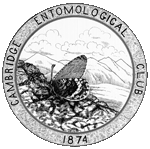
| January 2008: Psyche has a new publisher, Hindawi Publishing, and is accepting submissions |
Article beginning on page 224.
Psyche 3:224, 1880.
Full text (searchable PDF)
Durable link: http://psyche.entclub.org/3/3-224.html
The following unprocessed text is extracted from the PDF file, and is likely to be both incomplete and full of errors. Please consult the PDF file for the complete article.
PSYCHE.
CAMBRIDGE, MASS., JUNE 1881.
-
Cummtfnicafions, exckmiges and ediiers' espies should bs addressed to EDITORS or PSYCHE, Cam- briiifc, Miss. Cowtrnwiicatioss fw pstWcatuiit {╠ PSYCHE mssi be properly a╠÷the╠÷iicats and via ascay- mms articles M'II 6e $#Mished.
Editors and cuntr~?#fors an ody respoitsiblu far the statements mad8 in tfteir own ~mmunicutiort~. Warts on xubjecfsyut related to eatornulogy will mi be revimd in PSYCHE.
For rafts of sufiscrt'phffn and of advertising, set advwttStJW cu/ztms~t
PROCEEDINGS OF SOCIETIES.
3 FEB. 188t.-. . . A paper was read by
Mr. A. D. Michael, entitled, Observations on the life history of gamasifiue. In this the author endeavors to decide some of the dis- puted and knotty points in reference to these humble parasites; Mr. M<-gnin of Versai!les and Dr. Kramer of Schleusingen, both good authorities on the subject, being at variance thereon. Mr. Michael, believing that detach- ed observations on captured specimens may have produced unreliable results, has himself bred gamasids, closely followed their changes and growth, and watched their manners, and thus has arrived at what he assumes on good grounds to be important results respecting their life-history. He states that the remark- able power of starting each mandible separ- ately with speed and accuracy of aim far in advance of the body, the powerful hetractile muscles attached to these mandibles, the organization of the remainder of the mouth, the extreme swiftness of the creatures, the use of the front legs, as tactile organs only, and not for the purpose of locomotion, and the ample supply of tactile hairs in front only, seem to fit the animals for a predatory Me, and point to habits similar to those of Chey- letus and Trom&sdiwm, rather than to those of the true vegetable-feeders, such as the oribdidae and tetronycki. He further con- cludes : I, that M4gnin is correct in saying Gamasus coleojtratorum, and other allied creatures, with the conspicuously divided dorsal plates, are not species at all, but are immature stages of other species; 2, that the division of the dorsal plate is, in most cases at all events, a question of degree, and does not form a sound baas for classification, as applied by Koch, Kramer and others; 3, that the dorsal plates do not grow gradually, but alter in size, shape, or development of the ecdysh ; 4, that Mbgnin is right in saying that the characteristic of the so-called G. maygiwaivs is simply a provision possessed by the females of a large number of species ; 5, that the extent of the white margin de- pends upon the; extent to which the abdomen is distended by eggs; 6, that M&gnin is in error in saying that G. coleofi~utorum is the nymph of G. crassifes. The nymph of
crasaifes does not show any divided dorsal plates which can be seen on the living crea- ture; 7, that in the species bred there has not been observed any inert stage before the transformations or ecdysis ; 8, that in the same species copulation takes place with the adult female and not with the immature one, fts Mignin contends, and that it is by the vulvn not the anus.-Zoologtscker Anzeigw, 2S Mnr. 1881, jahrg. 4, no. 79, p. 167-168. 15 FEB. 1881.-. . . The Rev. 0. P. Cam-
bridge, C. M. Z. s., exhibited and made re- marks on a hymenopterous parasite, hatched from larvae found on two spiders, Lhyjhia obscwu, Biackw. $ and L. xeliriaa, Mange 3. The larvae were .stated to be apodous, and to adhere to the abdomen of the spider, which, when full grown, they fully equalled in size. Lord Walsingham read a paper on ~ome new and little known species of North American iiucidae, amongst which were three new
generic forms. - P. L. Sclater, in Zool. Anzezger, 7 March 1831, p. 117-1 ~8.
================================================================================
Volume 3 table of contents